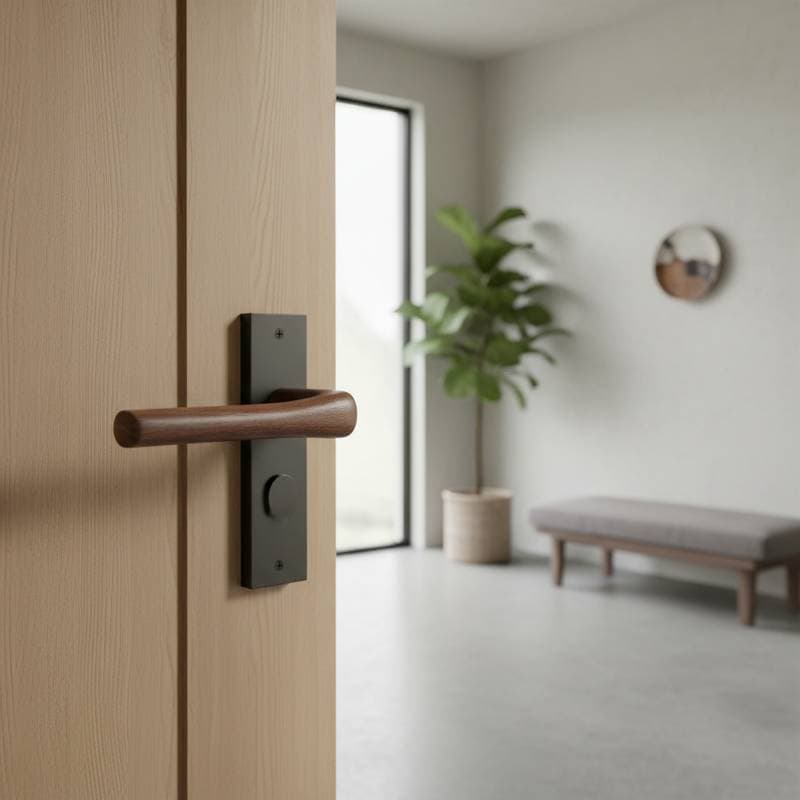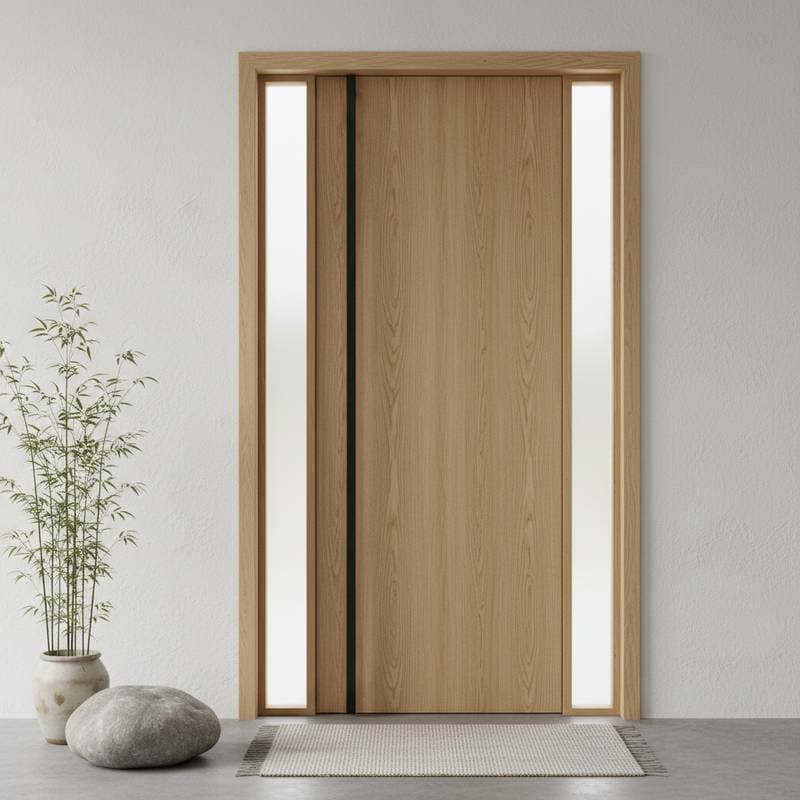Minimalist Wood Tones: The Warm Welcome Defining Modern Entryways
Soft grain patterns, natural finishes, and uncluttered surfaces transform the way homeowners design entryways. Minimalist wood tones lead exterior design trends by delivering quiet sophistication and tactile warmth to the home's first impression. This approach achieves balance through simplicity paired with natural detail, resulting in a calm and grounded aesthetic that appears modern yet timeless.
The trend draws from Japandi principles, blending Japanese restraint with Scandinavian coziness. This combination produces an exterior that feels light, intentional, and connected to nature. Homeowners select wood tones that emphasize organic texture over high-gloss finishes or heavy ornamentation. When integrated with sleek window frames, understated hardware, and cohesive siding, the design establishes calm continuity from exterior to interior.
Why This Look Works
Minimalist wood tones soften contemporary architecture and introduce warmth to clean-lined homes. Light oak, ash, and maple finishes showcase natural grain without dominating modern facades. The style bridges various architectural influences, offering adaptability across regions. Pair these tones with white stucco, dark fiber cement siding, or natural stone to form a balanced composition that conveys intention.
The understated palette conceals wear with grace. Unlike painted or high-contrast finishes that reveal every scratch or fade, natural wood tones develop character over time. They encourage touch and reflect light variably throughout the day, providing entryways with dynamic yet grounded qualities.
Three Ways to Get This Look
Save Approach ($3,000 - $6,000)
Select engineered wood doors with factory-applied woodgrain finishes for material choices. Vinyl or aluminum-clad windows with faux-wood interiors replicate the appearance without solid wood maintenance.
Focus investment on the front door, as texture and tone create the strongest first impression through cost-saving techniques. Maintain a clean aesthetic by using simple window grids and avoiding divided lites.
Choose quality hardware in matte black or brushed nickel for contrast as a splurge area. Modest materials gain refinement when paired with well-designed handles and hinges.
Mid-Range Approach ($6,000 - $12,000)
Opt for real wood veneer doors sealed with UV-resistant clear coats in balanced selections. Combine wood-framed windows or composite options that include real wood interiors and durable exteriors.
Add insulated glass and weather-sealed frames for energy efficiency through performance upgrades. Consider fiber cement or engineered siding in warm neutral tones such as sand or taupe to complement the wood.
Upgrade to wide plank siding or a vertical board pattern for subtle architectural rhythm as a design investment. Select a pivot-style entry door to establish a clean and modern presence.
Invest Approach ($12,000 - $25,000)
Install solid oak or teak doors with custom stain finishes for premium materials that deliver unmatched richness. Pair them with aluminum-clad wood windows featuring slim profiles to highlight natural grain.
Incorporate concealed hinges, flush thresholds, and integrated lighting to enhance minimalist appeal through high-end details. Extend wood cladding across the entry wall for seamless visual transition.
Premium wood species and professional sealing extend longevity as long-term value considerations. These elements resist warping, preserve color depth, and boost resale appeal via craftsmanship and authenticity.
Material and Finish Guide
Choose slim-framed casement or fixed-pane windows in black, bronze, or warm gray for windows. Add interior frames in light oak or walnut for depth. Select minimal hardware with linear handles or concealed latches.
Look for horizontal or vertical wood grain patterns that align with the home's geometry in doors. Apply stain finishes in honey oak, whitewashed ash, or smoked walnut to retain natural tone. Include frosted or ribbed glass inserts for privacy while allowing light flow.
Use smooth or lightly textured fiber cement panels, cedar planks, or engineered wood siding in complementary tones for siding. Install vertically to emphasize height and align with door grain.
Keep trim narrow and recessed for trim and accents. Employ aluminum or powder-coated steel in matte finishes to outline shapes without diverting attention from the wood. Feature simple geometric forms in dark metal or natural brass for entry lighting.
Maintenance Reality Check
Minimalist wood tones demand thoughtful upkeep to sustain calm beauty. Factory-finished veneers or composite materials lower maintenance yet may lack real wood depth. Solid wood doors require periodic sealing to avoid fading and moisture absorption.
In humid regions, reapply protective finishes every few years to uphold color integrity. Inspect wood-framed windows for cracking or peeling, particularly on sun-facing elevations. Select aluminum-clad exteriors to shield wood from weather if lower maintenance appeals.
Fiber cement or engineered siding provides wood-like warmth with minimal effort, needing only gentle washing to remove dirt and pollen. Clean routinely with mild soap and water to preserve glass clarity and finish sheen. Avoid abrasive cleaners that dull natural grain. Preserve material authenticity without constant restoration for enduring simplicity.
Avoid These Mistakes
- Overmixing tones: Multiple wood shades create chaos. Select one dominant tone and introduce subtle variations for depth.
- Ignoring proportion: Large solid doors overwhelm smaller facades without balance. Incorporate side lites or vertical glass panels for scale and light.
- Budget trap: Inexpensive stained composites result in peeling and uneven fading. Choose factory-applied coatings or UV-protected laminated veneers.
- Maintenance oversight: Unsealed real wood weathers quickly. Establish a schedule for inspection and resealing to safeguard investment.
Color and Style Coordination
Build a cohesive exterior palette around the wood's natural tone. These combinations align with minimalist principles:
- Ash and Charcoal: Light ash door with charcoal window frames and gray fiber cement siding for monochrome balance.
- Honey Oak and Warm White: Golden oak door with creamy siding and brushed nickel hardware for inviting softness.
- Smoked Walnut and Sand: Deep brown doors with sandy beige siding and black trim for contemporary contrast.
- Driftwood and Slate: Weathered gray wood tones with dark slate cladding for coastal minimalism.
- Natural Maple and Graphite: Pale maple entry with graphite metal accents and light gray walls for modern warmth.
These pairings adapt to climates and styles while preserving visual calm.
Planning Photography Checklist
Document existing conditions before selecting finishes or materials. This step ensures choices align with architectural character and needs.
- Capture exterior photographs from multiple angles, including close-ups of entry doors, window trims, and siding joints.
- Identify architectural style and elements to guide proportion and tone.
- Review neighborhood character and HOA restrictions on materials or colors.
- Note sunlight, moisture, or salt exposure for finish performance.
- Define budget parameters and priority areas, such as the front entry.
Photograph roof color, driveway texture, and landscaping to coordinate tones. A warm wood door complements gray stone pavers or black window frames when viewed in images.
Regional Design Adaptations
Minimalist wood tones adapt to climates with appropriate materials and finishes.
- Hot climates: Lighter stains like ash or white oak reflect sunlight. Apply UV-resistant sealants and use overhangs for shading.
- Cold climates: Medium to dark stains absorb warmth and minimize snow staining. Insulated wood or composite doors enhance energy efficiency.
- Coastal regions: Teak or cedar resists salt. Aluminum-clad window exteriors prevent corrosion.
- Arid zones: UV-stable finishes and smooth surfaces resist dust. Rinse regularly to avoid dulling.
- Humid climates: Engineered wood or composite siding prevents swelling and mildew. Ensure ventilation behind cladding.
These modifications uphold the aesthetic while promoting durability.
Making It Personal
Minimalist wood tones rely on restraint yet allow quiet individuality. Express personality through subtle details like a custom aged brass door pull, narrow vertical glass insert, or soft matte finish. These elements distinguish the entryway without disrupting serenity.
Mirror the entry door's wood tone on interior trims or stair treads for cohesive transition. Align grain direction or finish sheen to foster continuity. Select warm white bulbs in simple wall sconces to highlight wood texture without overpowering it.
Carefully planned minimalist wood tones elevate curb appeal and evoke calm arrival. They promote refined simplicity where material honesty and craftsmanship communicate quietly. Achieved via engineered or handcrafted elements, this design delivers lasting comfort and understated beauty that welcomes guests with warmth and intention.






